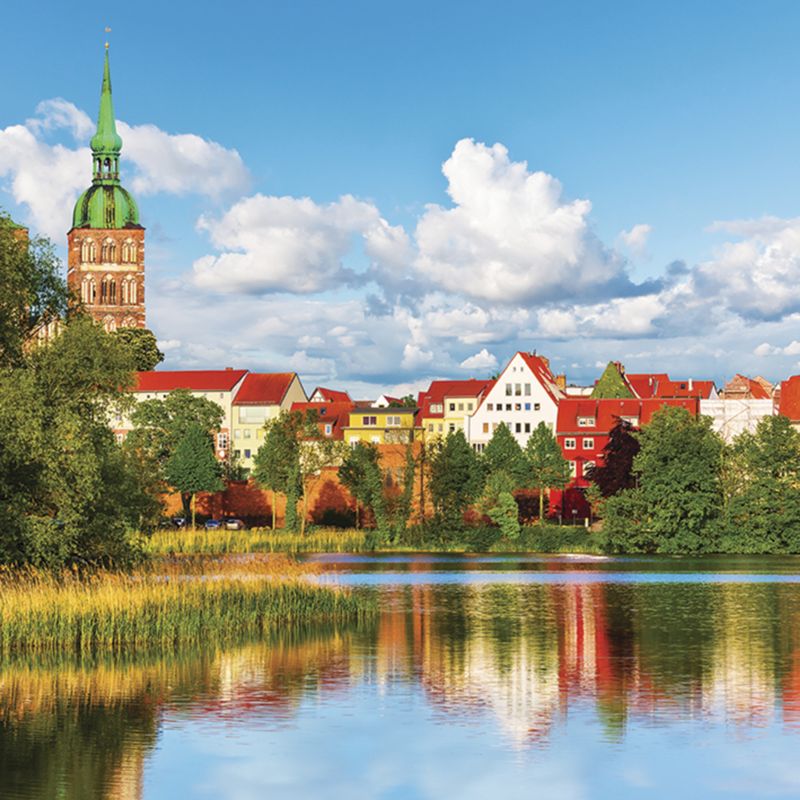- Home
- News, Articles & Reviews
We are hiring! Please click here to join our growing magazine delivery team in Gloucestershire!

Along Germany’s Hanseatic coast
All Areas > Travel > Holidays & Travel
Author: Al Hidden, Posted: Monday, 24th February 2020, 09:00
Bright spring sunshine makes rainbows among the jets of Rostock’s Joy of Life fountain on Kröpeliner Straße. As we admire the multi-coloured, step-gabled buildings around us, we’re part way through a west-to-east rail tour of four historic German Hanseatic ports – Lübeck, Rostock, Stralsund and Greifswald.
Rostock’s many delights
Our sojourn began in historic Lübeck, the world’s marzipan capital, with a stay at the Hotel Lindenhof just five minutes from the city’s main station. Now, days later and a couple of hours along the Baltic coast, we’re enjoying Rostock’s many delights.
When we’re done with the university, Neuer Markt, botanical garden, and the fifteenth century astronomical clock in St Mary’s Church, Warnemünde’s lighthouse and magnificent 9.5km beach are a short S-Bahn ride away.
Too soon, we’re on another train, heading for Stralsund, which was founded in easy-to-remember 1234. Further east again, it’s one more Hanseatic gem with copious red-brick architecture, the fourteenth-century Marienkirche and the ultra-modern Ozeaneum aquarium.
Seafood is a big part of Baltic coast life
Alongside typical northern German cuisine, seafood is a big part of Baltic coast life. If this is your taste, try delicious Fischbrötchen – fish sandwiches – at Stralsund’s Fischhalle or Nur Fisch (‘Fish Only’). Alternatively, savour simple-but-mouthwatering roast fish dishes at waterfront Speicher 8 (‘Store Number 8’).
Greifswald, our fourth stop, just 50km from the Polish border, is another Hanseatic university city. Allow at least a couple of days to relish the Pommersche Landesmuseum, Gothic St Nikolei cathedral, and even more piscatorial feasting.
Try the Fischer-Hütte or, after local Zwickel Bier at the Fritz Braugasthaus, head for the fishing village suburb of Wieck for Wiecker-style fish soup overlooking the distinctive Dutch-style drawbridge.
Rügen’s island attractions
Before leaving Germany’s Baltic coast, consider two more rail excursions. An hour to the north, the varied attractions of Rügen (Germany’s largest island) await – not least its golden beaches, white chalk cliffs and Prora’s massive Nazi-era, Strength through Joy (Kraft durch Freude) holiday apartments.
Alternatively, an hour east of Greifswald, Peenemünde’s Historical Technical Museum, the site of WW2 V1 and V2 missile research, is also worth visiting.
Whether you seek stunning beaches, Hanseatic architecture, wartime technology or superb seafood, Germany’s Baltic coast offers an interesting alternative to more predictable European coasts. So how about letting the Deutsche Bahn take the strain from Lübeck to Greifswald as you enjoy a sublime Teutonic littoral experience!Copyright © 2025 The Local Answer Limited.
Unauthorized use and/or duplication of this material without express and written permission from this site's author and/or owner is strictly prohibited. Excerpts and links may be used, provided that full and clear credit is given to The Local Answer Limited and thelocalanswer.co.uk with appropriate and specific direction to the original content.More articles you may be interested in...


© 2025 The Local Answer Limited - Registered in England and Wales - Company No. 06929408
Unit H, Churchill Industrial Estate, Churchill Road, Leckhampton, Cheltenham, GL53 7EG - VAT Registration No. 975613000You are leaving the TLA website...
You are now leaving the TLA website and are going to a website that is not operated by us. The Local Answer are not responsible for the content or availability of linked sites, and cannot accept liability if the linked site has been compromised and contains unsuitable images or other content. If you wish to proceed, please click the "Continue" button below:




